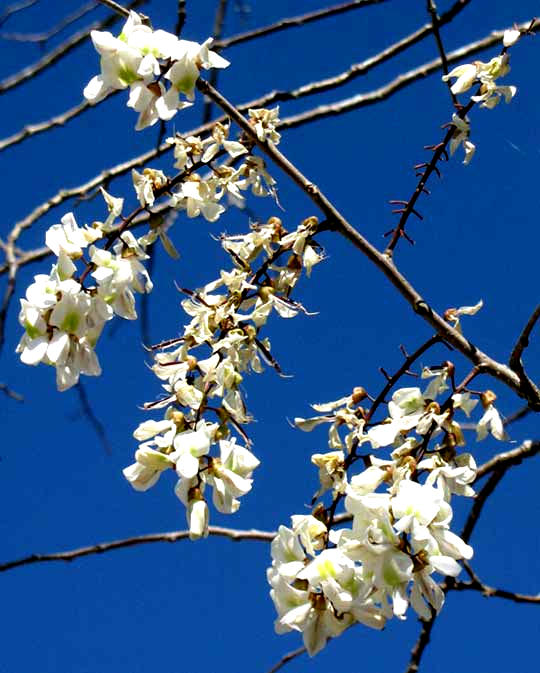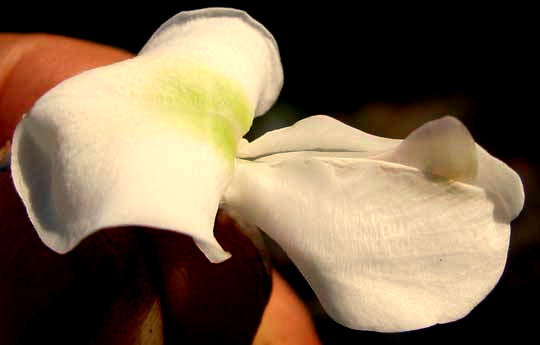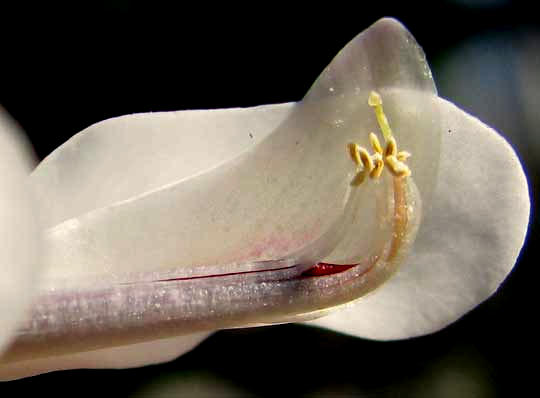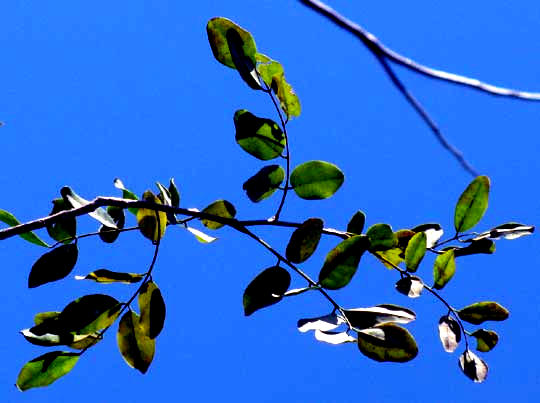Excerpts from Jim Conrad's
Naturalist Newsletter
from the February 6, 2011 Newsletter issued from Hacienda Chichen Resort beside Chichén Itzá Ruins, central Yucatán, MÉXICO; limestone bedrock, elevation ~39m (~128ft), ~N20.676°, ~W88.569°
TREE CALLED "SPRING"
Nowadays along Pisté's backstreets and in abandoned lots there's a small, leafless tree dazzlingly flowering and when I see its six-inch-long (15cm) racemes of glowing-white flowers against the blue sky, shaking in the wind, I'm filled with nostalgia. You can see a small part of one of these trees below:

A close-up of a ¾-inch long (2cm) flower is shown below:

The flowers may remind readers in the US Northeast of those of Redbuds, and that's appropriate because this tree like the Redbud is a member of the Bean Family. We've seen that most flowers in the Bean Family are "papilionaceous," with a big "standard" petal atop the blossom, two "wings" along the sides, and two petals below joined along their common margins to form a scooplike "keel." With that in mind I removed a flower's nearest wing and the near side of its keel so you can see how the flower's ten or so stamens' filaments are fused into a cylinder split at its top. The cylinder envelops the ovary, which has a slender, upturned style with a tiny, blunt stigma, as shown below:

Though here during the dry season most of these trees are leafless, a few are sprouting new foliage. You can see a tree's once-pinnate leaves, which look a lot like those of the US Northeast's Black Locust, below:

This is GLIRICIDIA SEPIUM and while it's a native to Mexico, Central America and northern South America, it's also one of the most widely planted of all trees in the world's tropics -- explaining why it has a world of common names, including the English ones Quick-Stick and Cacao Shade. Often English speakers call it by one of its Spanish names, Madre de Cacao.
The reason this tree is planted so often is that it's one of the most useful and welcome of all tropical trees. Cut a leg-long stick of it, shove it into the ground, and it grows into a new tree in a single season. Place many sticks in a row and in a few months you have a "living fence." Livestock love eating its leafy branches, and it's good for them, having a crude protein content of 18-30% and a high digestibility.
In Spanish sometimes the tree is called Mata Ratón, or "Mouse Killer," because leaves and bark mixed with ground corn can be used as a rodenticide.
Many years ago the first time I saw Gliricidia sepium so audaciously prettily flowering and abundant outside my south-moving, wintertime bus window I scooted toward the next seat and asked the straw-hat-wearing, stubbly-chinned old fellow there what the tree was called. "Primavera," he smiled... "Spring." It was a perfect name, for seeing it has always meant, to me, the end of that's season's winter.
By the way, usually "Spring's" flowers are pinkish, very reminiscent of the US's Redbuds, but flowers I've seen here are white as in the picture.
Entry with notes from an April 1, 2019 camping trip in Ceibal Archaeological Park about 15kms east of Sayaxché, Petén department, lowland northern GUATEMALA
MADRE DE CACAO'S LEGUMES
Here in the late dry season the thousands of Madre de Cacao trees (often called Primavera in Mexico) serving as living fenceposts along the gravel road north from El Paraiso to Ceibal, are mostly leafless, but on a few trees new leaves are emerging in anticipation of the rainy season, and many trees bear fruits, as shown below:

Since Madre de Cacao is a member of the huge Bean Family, the fruits are legumes, meaning that they are simple fruits splitting along two sides, and that the fruits contain just a single chamber, in which the seeds, or beans, normally line up in single file within the pod.
Madre de Cacao legumes are fairly easy to recognize because the are flattish, and when viewed from the side are somewhat irregularly formed, usually a bit enlarged toward the outer end, like the one on the left in the picture.